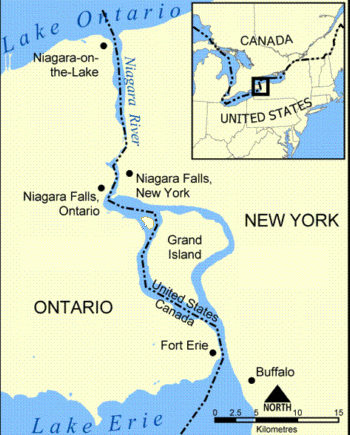 SKC Films Library |
| SKC Films Library >> American History >> United States: Local History and Description >> Middle Atlantic States >> New York |
| Niagara Falls The second largest falls in the world, behind Victoria Falls in southern Africa. The word "Niagara" is believed to have been derived from the Iroquis word "Onguiaahra," meaning "the strait." "Anatomy" of the Falls The falls are divided into two main areas, the Canadian, or Horseshoe, Falls, and the American Falls, which are separated by Goat Island, which lies in the river just above the falls. There is also a small fall, known as the Bridal Veil Fall, which is separated from the main American Falls by a small island.. The American Falls are about 1,060 feet across. Although the total height of the falls is 176 feet, the water only drops 70 feet due to a massive heap of rocks at the base of the Falls. About 150,000 gallons of water spill over the American Falls every second. Horseshoe Falls are about 2,600 feet across, and have a total drop of 167 feet. About 600,000 gallons of water pours over Horseshoe Falls every second, "landing" in a pool that reaches a depth of 160 feet. About 20 percent of the world's total freshwater supply falls over Niagara every day. Geology of the Falls About 20,000 years ago, meltwater from retreating glaciers caused Lake Erie to overflow its basin, and that overflow gradually carved a 34-mile long channel to Lake Ontario that is now known as the Niagara River. About 12,000 years ago, the river cut through the Niagara Escarpment, a high cliff composed of hard rock, at a point near present day Lewiston, New York, to form the first falls. The falls have been moving upriver ever since as the falling water constantly wears away softer rock at the base, causing the harder surface rock to collapse. It is not known exactly when the falls reached their present location, but general scientific consensus says it was no more than 10-11,000 years ago. Goat Island, which separates American and Horseshoe Falls, formed about 500 years ago when the river encountered an unknown obstacle; it was named by John Stedman, whose goat herds froze to death on the island in the winter of 1870. The falls continue to move upriver, and they will eventually advance far enough to literally drain Lake Erie, as the bottom of the lake is higher than the bottom of the falls.
|
| SKC Films Library >> American
History >> United States:
Local History and Description
>> Middle
Atlantic States >> New York This page was last updated on October 27, 2017. |
